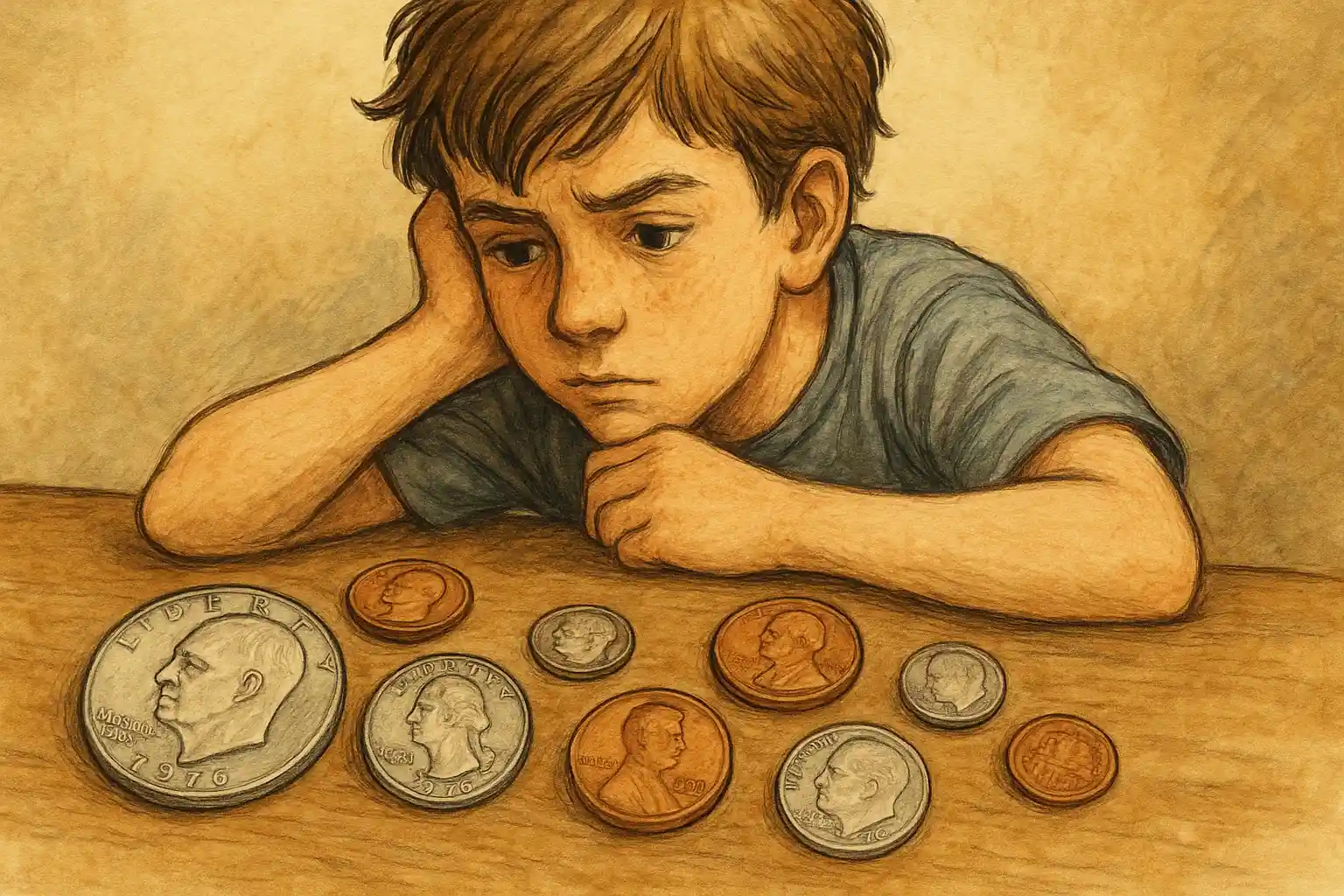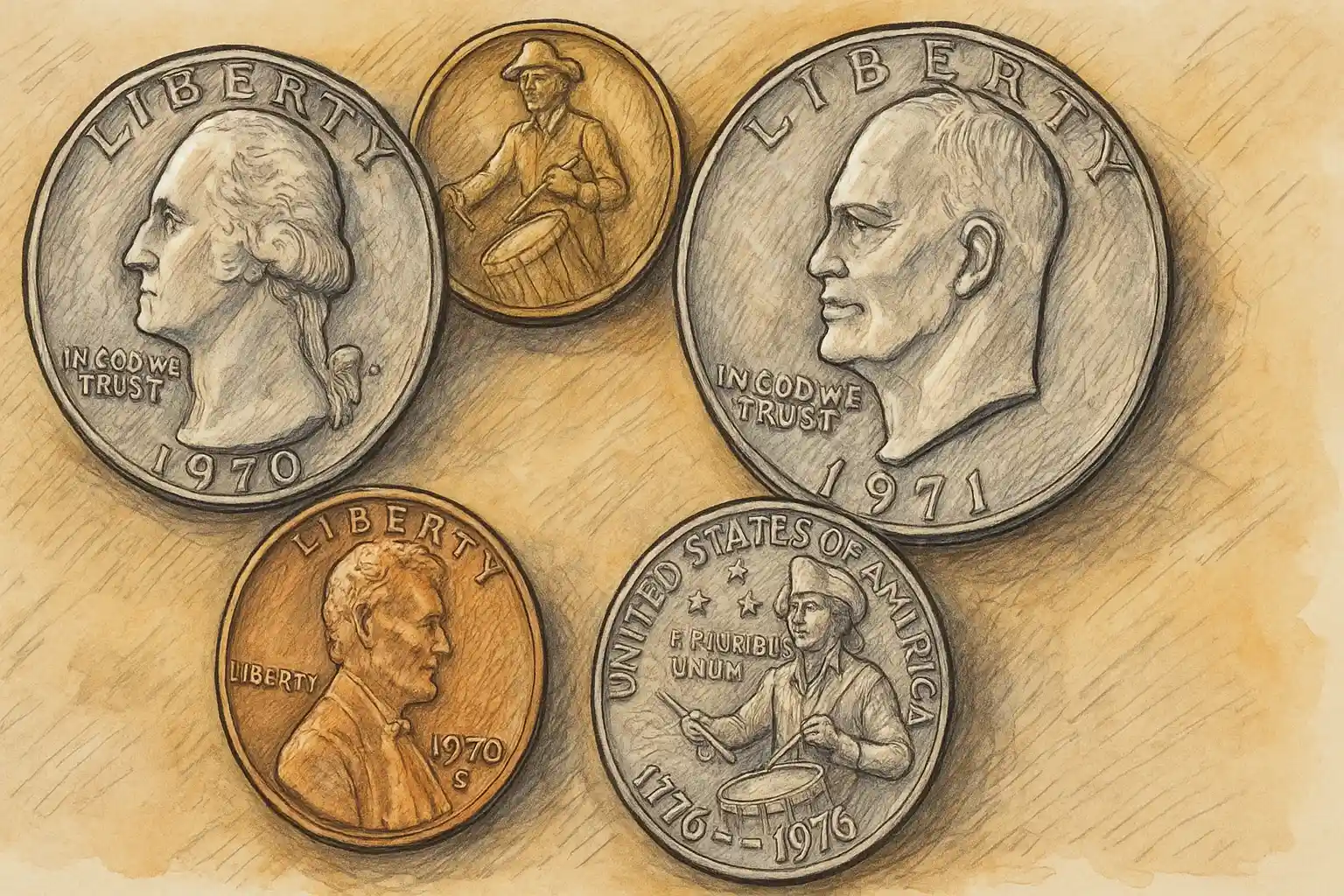Which U.S. Coins from the 1970s Deserve a Place in Your Coin Collection?
The 1970s were a dynamic decade for U.S. coinage — a time of design changes, experimental minting, and a handful of rare varieties that have become sought-after treasures among collectors. Whether you’re a seasoned numismatist or just starting your journey, even a simple 1979 dollar coin can offer a mix of history, artistry, and potential value that’s hard to resist.
If you’ve ever wondered which 1970s coins could be worth adding to your collection, the answer lies not only in rarity but also in the stories they carry. From unusual minting errors to commemorative designs celebrating America’s milestones, the decade gave us some fascinating issues that remain attractive to collectors today.

1. 1970-S Large Date Doubled Die Obverse Penny
The 1970-S Large Date Lincoln cent is one of the most famous and valuable pennies from the decade — especially the proof variety featuring a doubled die obverse.
Defining Feature: Strong doubling visible on the date “1970” and the motto “IN GOD WE TRUST.”
Why It’s Valuable: Proof coins with this error are extremely scarce, with high-grade examples selling for over $24,000 at auction.
Collecting Tip: Look for sharp, clear doubling using a 10x magnifier or digital coin scope. The Large Date version is also distinguishable from the Small Date by its thicker, more pronounced numerals.
Quick Reference Table – 1970-S Large Date DDO Penny
Attribute | Detail |
Composition | 95% copper, 5% zinc |
Mint Mark | S (San Francisco) |
Notable Variety | Doubled Die Obverse (proof) |
Auction Record (Proof 67) | $24,150 |
Collectability Level | Very High |
2. 1970 Quarters and Rare Errors
Early 1970s Washington quarters can be common in circulated condition — but certain varieties and mint errors can fetch serious premiums.
Error Highlights:
1970-D Quarter on Dime Planchet: Struck on the wrong metal stock, producing a thinner and lighter coin.
Off-Center Strikes: Where part of the design is missing due to misalignment during minting.
Double-Strikes: Coins struck twice, often creating overlapping details.
Foreign Planchet Strikes: Quarters accidentally struck over Canadian coins.
Some of these rare errors have sold for $1,000–$3,000 depending on condition and rarity.
Example Table – Common vs. Error Quarter Values
Coin Type | Approx. Value (XF–MS) |
Standard 1970-D Quarter (circulated) | $0.25–$0.50 |
1970-D on Dime Planchet (error) | $1,200–$3,000 |
Double-Strike Error | $250–$1,000+ |
Struck Over Foreign Coin | $500–$2,500 |
3. 1976 Bicentennial Coins
The U.S. Mint celebrated the 200th anniversary of American independence with redesigned quarters, half-dollars, and dollar coins. These coins, dated “1776–1976,” are among the most popular modern commemoratives.
Design Notes:
Quarter: Colonial drummer reverse by Jack L. Ahr.
Half-Dollar: Independence Hall reverse by Seth G. Huntington.
Dollar: Liberty Bell and moon reverse by Dennis R. Williams.
Value Factors: While the copper-nickel clad versions are plentiful, the 40% silver proof and uncirculated setscarry more collector value, especially in high grades. Some mint errors — like missing lettering or die clashes — can add further premiums.
Bicentennial Coin Type | Common Value | Silver Proof Value |
Quarter (clad) | $0.25–$1 | $4–$8 |
Half-Dollar (clad) | $0.50–$1 | $6–$12 |
Dollar (clad) | $1–$2 | $9–$18 |
4. Eisenhower Dollar (1971–1978)
The Eisenhower dollar holds a special place in U.S. coinage history as the first dollar coin issued since the Peace dollar series ended in 1935. Introduced in 1971, it honored both President Dwight D. Eisenhower and the Apollo 11 moon landing.
Design Details:
Obverse: Portrait of Eisenhower by Frank Gasparro.
Reverse: Apollo 11 mission insignia — an eagle landing on the moon, adapted from the official NASA emblem.
Collecting Insights: Circulating issues were copper-nickel clad, while 40% silver versions were produced for collectors in both uncirculated and proof finishes. Key dates and varieties include the 1972 Type 2 Reverse, which shows more detailed islands near Florida and is considerably scarcer than Types 1 and 3.
Eisenhower Dollar Type | Composition | Approx. Value (MS65) |
1971–1978 Copper-Nickel Clad | Copper-Nickel | $15–$40 |
40% Silver (Uncirculated/Proof) | 40% Silver | $25–$50 |
1972 Type 2 Reverse (Copper-Nickel) | Copper-Nickel | $150–$300 |
5. Rare 1970s Proof Coins
San Francisco–minted proof coins, especially those with the “S” mintmark, were struck with exceptional detail and mirror-like surfaces. They were never intended for circulation and are often housed in original U.S. Mint packaging.
Top Standouts:
1975 No “S” Proof Dime: Perhaps the rarest proof coin of the decade — only two examples are known to exist, each valued at hundreds of thousands of dollars.
1971–1979 Proof Pennies & Quarters with Varieties: Doubled dies, cameo contrasts, and striking errors can boost values substantially.
Quick Tip for Collectors: Proof coins are best handled by their edges and stored in protective capsules to avoid damage to their delicate surfaces.
Notable Proof Variety | Known Examples | Potential Value |
1975 No “S” Proof Dime | 2 | $350,000+ |
1971-S Proof Lincoln Cent DDO | Unknown | $200–$1,000+ |
1976-S Silver Proof Bicentennial | Common | $10–$20 |

Collecting Copper-Nickel Clad Coins
Though many 1970s copper-nickel clad coins — like dimes, quarters, half-dollars, and Eisenhower dollars — are common in circulated grades, certain uncirculated or error specimens can command higher values.
Why Keep Them: They offer an affordable way to build complete date-and-mint sets, and they can serve as placeholders until you find rarer silver or variety coins.
Error Examples Worth Spotting: Misaligned dies, broadstrikes, and clipped planchets. Even a minor but clear minting error can turn a 25¢ piece into a $50 collectible.
Common vs. Error Copper-Nickel Clad Coin Values
Coin Type | Common Circulated Value | Error Coin Value |
1972-D Quarter | $0.25–$0.50 | $50–$300+ |
1974-D Half-Dollar | $0.50–$1 | $75–$250+ |
1978 Eisenhower Dollar | $1–$2 | $100–$500+ |
Staying Organized and Learning More with Coin ID Scanner
Building a 1970s U.S. coin collection is exciting — but as your collection grows, keeping track of every piece, variety, and value can quickly become overwhelming. That’s where modern tools like Coin ID Scanner come in. Designed for collectors of all levels, it combines convenience with powerful research capabilities.
Key Features for 1970s Coin Collectors:
Coin Identification by Photo: Snap or upload a picture of your coin, and the app will display a detailed profile — including mintage years, country, coin type, edge style, metal composition, weight, diameter, and estimated value.
Collection Management: Create a digital inventory of your coins, complete with notes and images, so you always know what’s in your collection and what’s missing.
Extensive Global Database: With information on over 187,000 coins from around the world, you can explore beyond 1970s U.S. issues and compare varieties.
Smart Filters (Premium): Easily sort and find coins by year, mint mark, metal, or value — especially helpful when searching for specific 1970s varieties.
AI Coin Helper: Get tips on identifying errors, confirming authenticity, and learning more about your coin’s history.
Coin ID Scanner Feature | How It Helps Collectors |
Photo-Based Identification | Confirms coin type and variety |
Digital Collection Management | Organizes and tracks inventory |
Large Database | Enables detailed comparisons |
AI Coin Helper | Offers expert-like insights |
For anyone serious about maintaining a clean, accurate, and valuable collection, pairing traditional coin hunting with tech tools like this can save hours of research and reduce the risk of misidentifying a piece.
Final Tips for Building a 1970s U.S. Coin Collection
Whether you’re seeking the elusive 1970-S Large Date Doubled Die Penny or hunting for Bicentennial silver proof sets, here are a few strategies to keep your collection both enjoyable and potentially profitable:
Prioritize Condition: High-grade coins often appreciate more in value over time. Look for coins with minimal wear and strong details.
Verify Varieties: Many 1970s rarities are subtle — invest in a magnifier or digital scope to catch doubling, planchet differences, or mint errors.
Buy from Reputable Sources: Attend coin shows, work with trusted dealers, and participate in reputable auctions to avoid counterfeits.
Document Your Collection: Maintain clear records of where and when you acquired each coin, along with purchase price and condition notes.
Stay Educated: Read numismatic publications, follow auction results, and keep up with coin market trends.
The 1970s gave U.S. coinage enthusiasts a rich mix of history, artistry, and variety. From rare proof errors like the 1975 No “S” dime to the patriotic Bicentennial series, this decade offers something for every type of collector. By blending hands-on searching with modern tools like the Coin ID Scanner, you can not only find and preserve valuable coins but also deepen your understanding of their stories and significance.
